Audit Assignment 1: Inventory, IPR, and Audit Risk Assessment
VerifiedAdded on 2023/06/07
|12
|2470
|265
Report
AI Summary
This audit assignment focuses on the risk assessment and substantive audit procedures related to inventory and intellectual property rights (IPR). It identifies key assertions at risk, such as valuation and rights & obligations, particularly concerning inventory obsolescence, goods in transit, and establishing ownership. The assignment details substantive audit procedures for both inventory and IPR, including inventory counts, verification of agreements, and assessment of research and development expenses. It also discusses the application of ASA 701 regarding key audit matters, emphasizing the importance of transparency in audit reports and highlighting areas requiring significant auditor attention, such as inventory valuation and IPR management. The report concludes by emphasizing the need for clear communication between auditors and management to ensure accurate financial reporting.
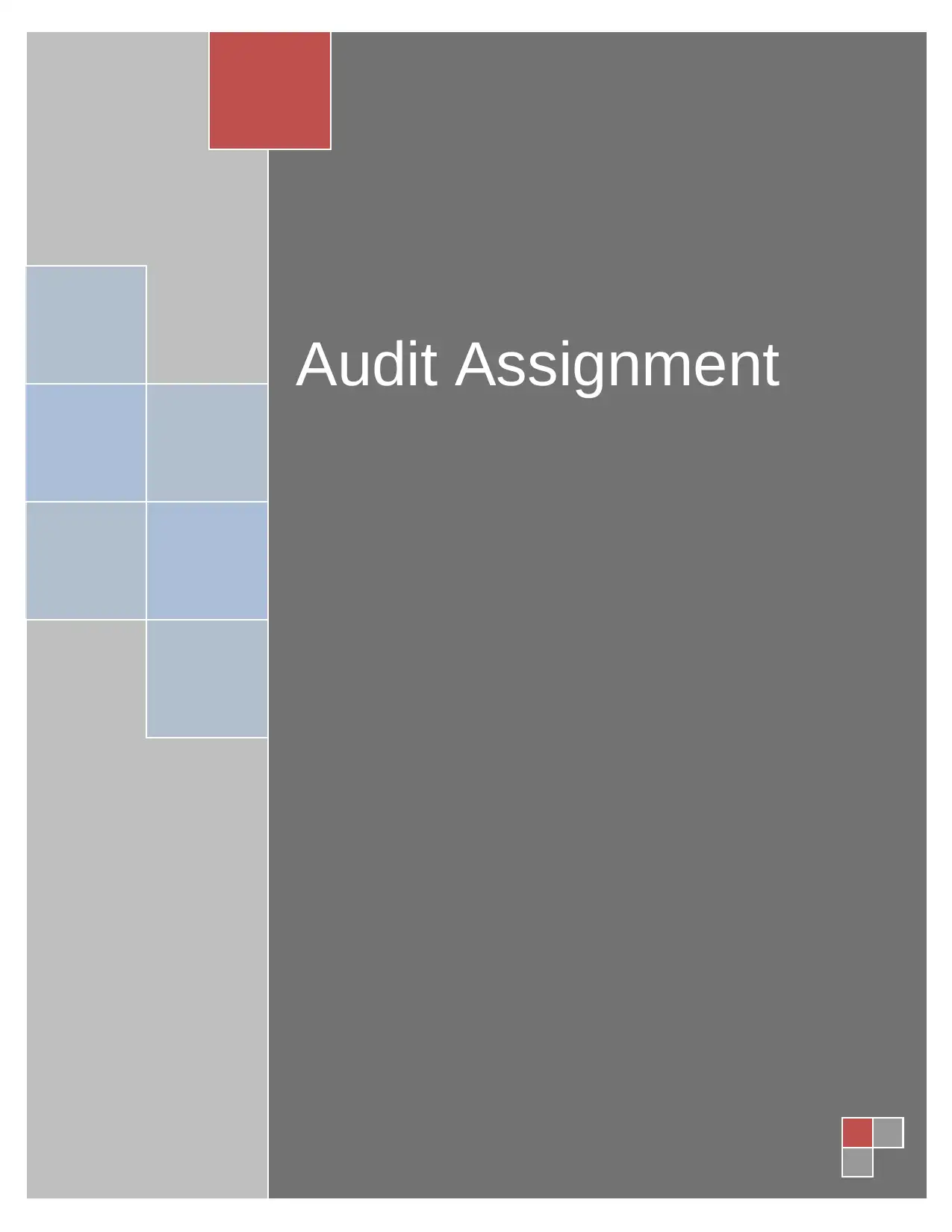
Audit Assignment
Paraphrase This Document
Need a fresh take? Get an instant paraphrase of this document with our AI Paraphraser
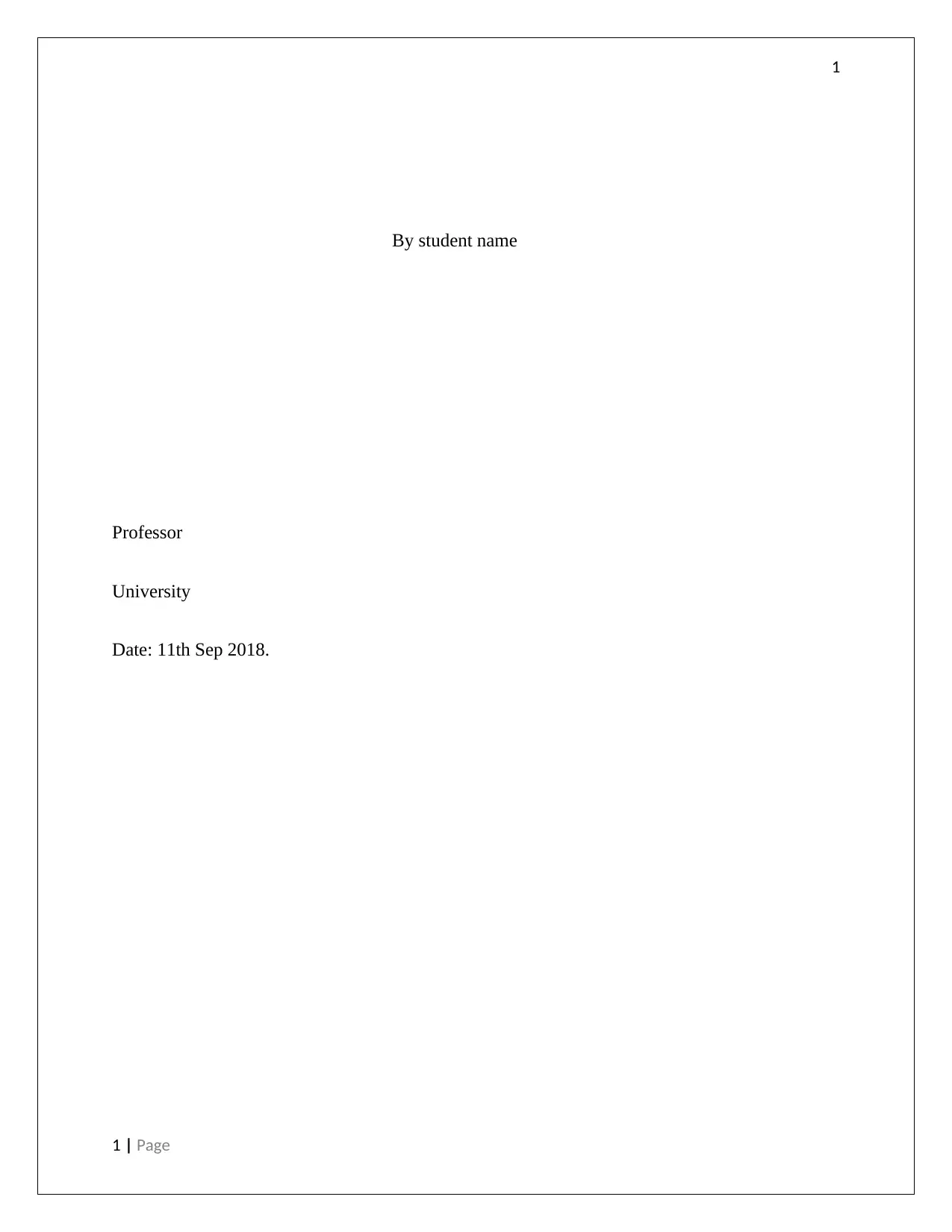
1
By student name
Professor
University
Date: 11th Sep 2018.
1 | Page
By student name
Professor
University
Date: 11th Sep 2018.
1 | Page
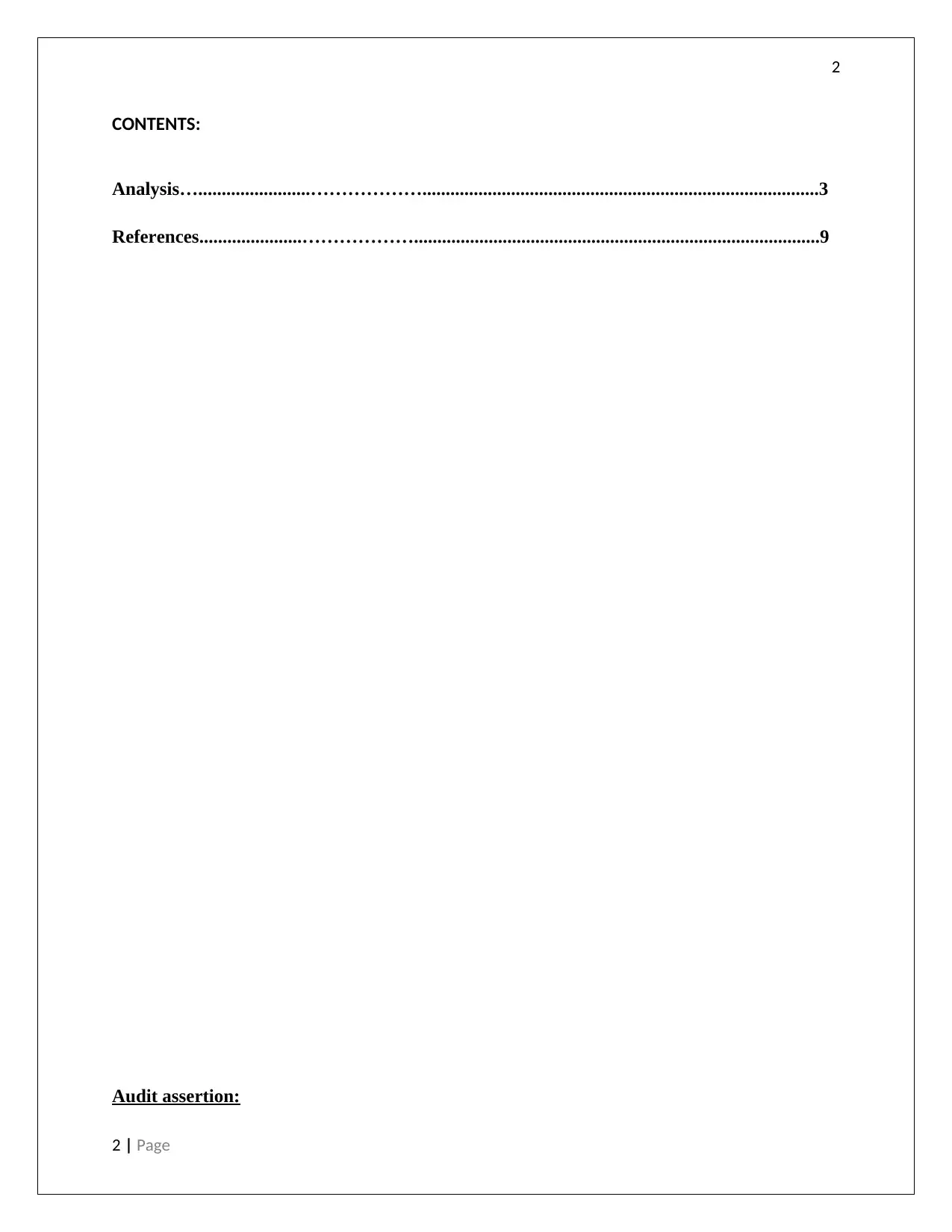
2
CONTENTS:
Analysis…........................……………….....................................................................................3
References......................……………….......................................................................................9
Audit assertion:
2 | Page
CONTENTS:
Analysis…........................……………….....................................................................................3
References......................……………….......................................................................................9
Audit assertion:
2 | Page
⊘ This is a preview!⊘
Do you want full access?
Subscribe today to unlock all pages.

Trusted by 1+ million students worldwide
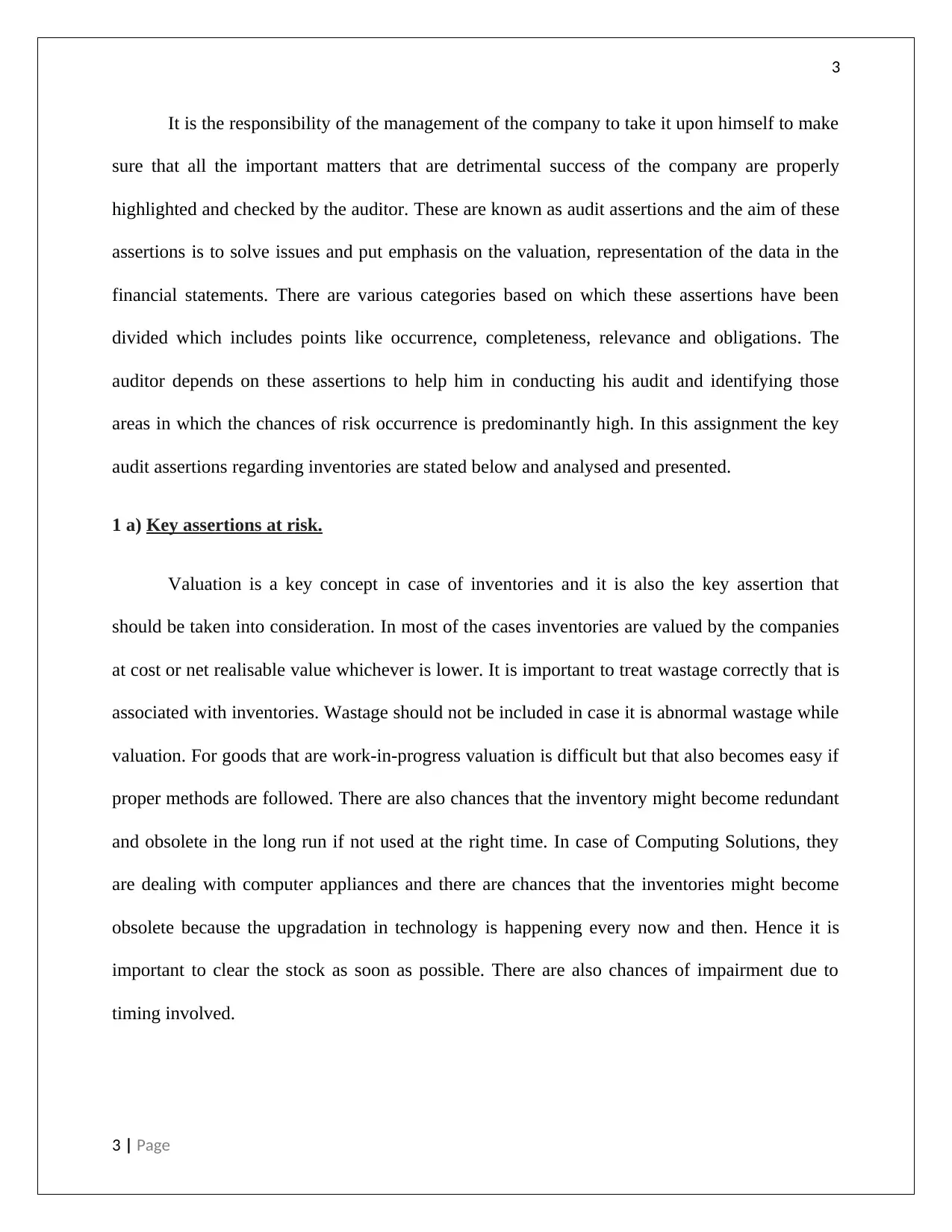
3
It is the responsibility of the management of the company to take it upon himself to make
sure that all the important matters that are detrimental success of the company are properly
highlighted and checked by the auditor. These are known as audit assertions and the aim of these
assertions is to solve issues and put emphasis on the valuation, representation of the data in the
financial statements. There are various categories based on which these assertions have been
divided which includes points like occurrence, completeness, relevance and obligations. The
auditor depends on these assertions to help him in conducting his audit and identifying those
areas in which the chances of risk occurrence is predominantly high. In this assignment the key
audit assertions regarding inventories are stated below and analysed and presented.
1 a) Key assertions at risk.
Valuation is a key concept in case of inventories and it is also the key assertion that
should be taken into consideration. In most of the cases inventories are valued by the companies
at cost or net realisable value whichever is lower. It is important to treat wastage correctly that is
associated with inventories. Wastage should not be included in case it is abnormal wastage while
valuation. For goods that are work-in-progress valuation is difficult but that also becomes easy if
proper methods are followed. There are also chances that the inventory might become redundant
and obsolete in the long run if not used at the right time. In case of Computing Solutions, they
are dealing with computer appliances and there are chances that the inventories might become
obsolete because the upgradation in technology is happening every now and then. Hence it is
important to clear the stock as soon as possible. There are also chances of impairment due to
timing involved.
3 | Page
It is the responsibility of the management of the company to take it upon himself to make
sure that all the important matters that are detrimental success of the company are properly
highlighted and checked by the auditor. These are known as audit assertions and the aim of these
assertions is to solve issues and put emphasis on the valuation, representation of the data in the
financial statements. There are various categories based on which these assertions have been
divided which includes points like occurrence, completeness, relevance and obligations. The
auditor depends on these assertions to help him in conducting his audit and identifying those
areas in which the chances of risk occurrence is predominantly high. In this assignment the key
audit assertions regarding inventories are stated below and analysed and presented.
1 a) Key assertions at risk.
Valuation is a key concept in case of inventories and it is also the key assertion that
should be taken into consideration. In most of the cases inventories are valued by the companies
at cost or net realisable value whichever is lower. It is important to treat wastage correctly that is
associated with inventories. Wastage should not be included in case it is abnormal wastage while
valuation. For goods that are work-in-progress valuation is difficult but that also becomes easy if
proper methods are followed. There are also chances that the inventory might become redundant
and obsolete in the long run if not used at the right time. In case of Computing Solutions, they
are dealing with computer appliances and there are chances that the inventories might become
obsolete because the upgradation in technology is happening every now and then. Hence it is
important to clear the stock as soon as possible. There are also chances of impairment due to
timing involved.
3 | Page
Paraphrase This Document
Need a fresh take? Get an instant paraphrase of this document with our AI Paraphraser
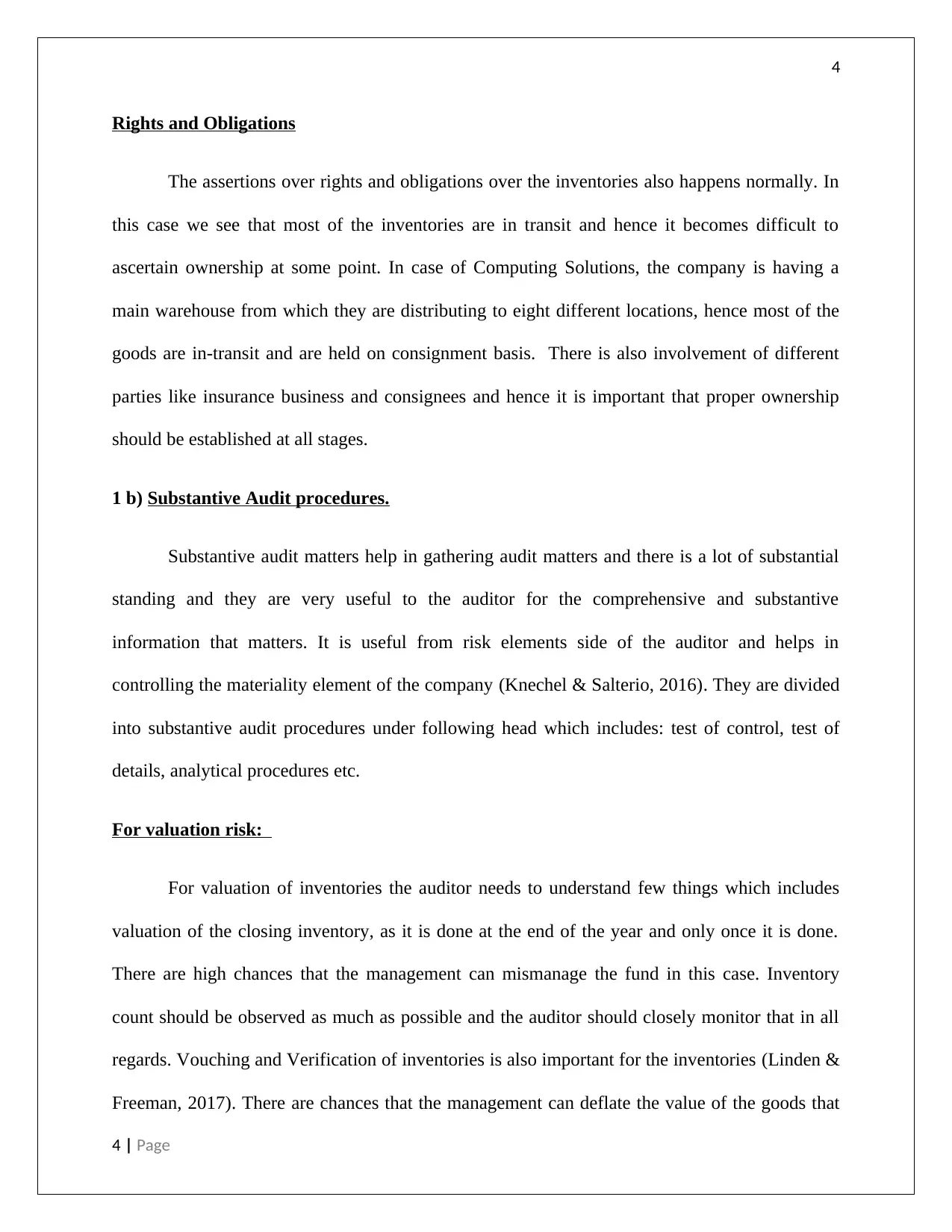
4
Rights and Obligations
The assertions over rights and obligations over the inventories also happens normally. In
this case we see that most of the inventories are in transit and hence it becomes difficult to
ascertain ownership at some point. In case of Computing Solutions, the company is having a
main warehouse from which they are distributing to eight different locations, hence most of the
goods are in-transit and are held on consignment basis. There is also involvement of different
parties like insurance business and consignees and hence it is important that proper ownership
should be established at all stages.
1 b) Substantive Audit procedures.
Substantive audit matters help in gathering audit matters and there is a lot of substantial
standing and they are very useful to the auditor for the comprehensive and substantive
information that matters. It is useful from risk elements side of the auditor and helps in
controlling the materiality element of the company (Knechel & Salterio, 2016). They are divided
into substantive audit procedures under following head which includes: test of control, test of
details, analytical procedures etc.
For valuation risk:
For valuation of inventories the auditor needs to understand few things which includes
valuation of the closing inventory, as it is done at the end of the year and only once it is done.
There are high chances that the management can mismanage the fund in this case. Inventory
count should be observed as much as possible and the auditor should closely monitor that in all
regards. Vouching and Verification of inventories is also important for the inventories (Linden &
Freeman, 2017). There are chances that the management can deflate the value of the goods that
4 | Page
Rights and Obligations
The assertions over rights and obligations over the inventories also happens normally. In
this case we see that most of the inventories are in transit and hence it becomes difficult to
ascertain ownership at some point. In case of Computing Solutions, the company is having a
main warehouse from which they are distributing to eight different locations, hence most of the
goods are in-transit and are held on consignment basis. There is also involvement of different
parties like insurance business and consignees and hence it is important that proper ownership
should be established at all stages.
1 b) Substantive Audit procedures.
Substantive audit matters help in gathering audit matters and there is a lot of substantial
standing and they are very useful to the auditor for the comprehensive and substantive
information that matters. It is useful from risk elements side of the auditor and helps in
controlling the materiality element of the company (Knechel & Salterio, 2016). They are divided
into substantive audit procedures under following head which includes: test of control, test of
details, analytical procedures etc.
For valuation risk:
For valuation of inventories the auditor needs to understand few things which includes
valuation of the closing inventory, as it is done at the end of the year and only once it is done.
There are high chances that the management can mismanage the fund in this case. Inventory
count should be observed as much as possible and the auditor should closely monitor that in all
regards. Vouching and Verification of inventories is also important for the inventories (Linden &
Freeman, 2017). There are chances that the management can deflate the value of the goods that
4 | Page
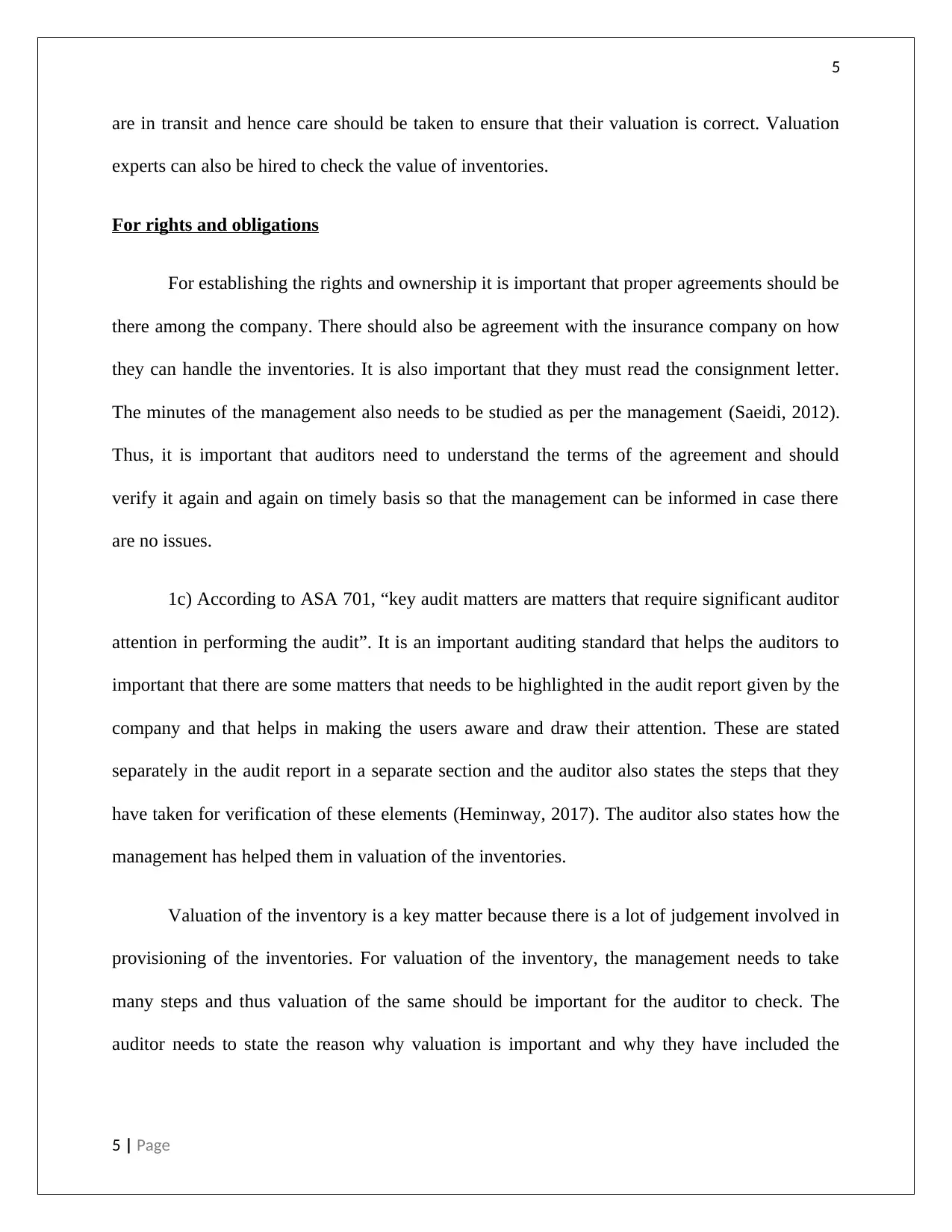
5
are in transit and hence care should be taken to ensure that their valuation is correct. Valuation
experts can also be hired to check the value of inventories.
For rights and obligations
For establishing the rights and ownership it is important that proper agreements should be
there among the company. There should also be agreement with the insurance company on how
they can handle the inventories. It is also important that they must read the consignment letter.
The minutes of the management also needs to be studied as per the management (Saeidi, 2012).
Thus, it is important that auditors need to understand the terms of the agreement and should
verify it again and again on timely basis so that the management can be informed in case there
are no issues.
1c) According to ASA 701, “key audit matters are matters that require significant auditor
attention in performing the audit”. It is an important auditing standard that helps the auditors to
important that there are some matters that needs to be highlighted in the audit report given by the
company and that helps in making the users aware and draw their attention. These are stated
separately in the audit report in a separate section and the auditor also states the steps that they
have taken for verification of these elements (Heminway, 2017). The auditor also states how the
management has helped them in valuation of the inventories.
Valuation of the inventory is a key matter because there is a lot of judgement involved in
provisioning of the inventories. For valuation of the inventory, the management needs to take
many steps and thus valuation of the same should be important for the auditor to check. The
auditor needs to state the reason why valuation is important and why they have included the
5 | Page
are in transit and hence care should be taken to ensure that their valuation is correct. Valuation
experts can also be hired to check the value of inventories.
For rights and obligations
For establishing the rights and ownership it is important that proper agreements should be
there among the company. There should also be agreement with the insurance company on how
they can handle the inventories. It is also important that they must read the consignment letter.
The minutes of the management also needs to be studied as per the management (Saeidi, 2012).
Thus, it is important that auditors need to understand the terms of the agreement and should
verify it again and again on timely basis so that the management can be informed in case there
are no issues.
1c) According to ASA 701, “key audit matters are matters that require significant auditor
attention in performing the audit”. It is an important auditing standard that helps the auditors to
important that there are some matters that needs to be highlighted in the audit report given by the
company and that helps in making the users aware and draw their attention. These are stated
separately in the audit report in a separate section and the auditor also states the steps that they
have taken for verification of these elements (Heminway, 2017). The auditor also states how the
management has helped them in valuation of the inventories.
Valuation of the inventory is a key matter because there is a lot of judgement involved in
provisioning of the inventories. For valuation of the inventory, the management needs to take
many steps and thus valuation of the same should be important for the auditor to check. The
auditor needs to state the reason why valuation is important and why they have included the
5 | Page
⊘ This is a preview!⊘
Do you want full access?
Subscribe today to unlock all pages.

Trusted by 1+ million students worldwide
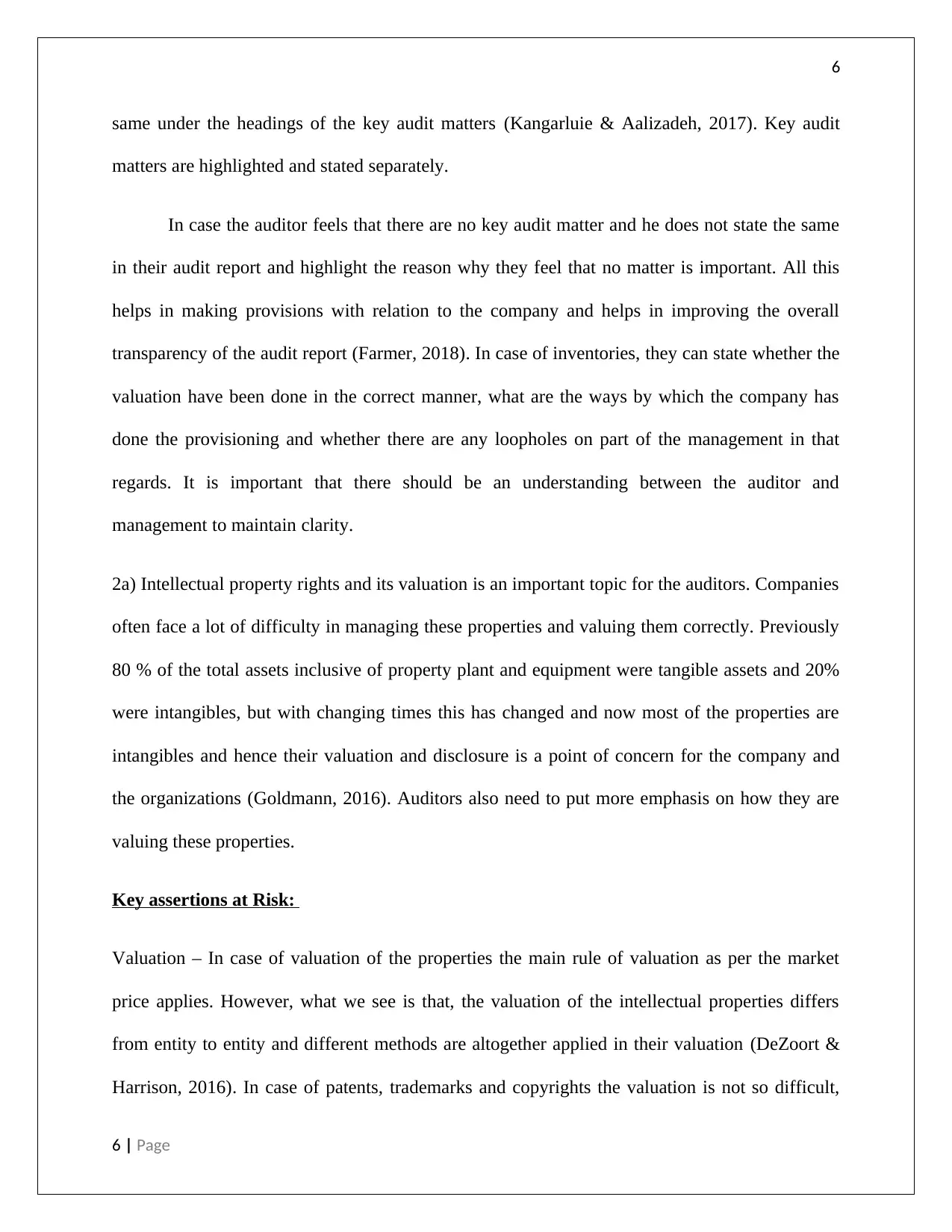
6
same under the headings of the key audit matters (Kangarluie & Aalizadeh, 2017). Key audit
matters are highlighted and stated separately.
In case the auditor feels that there are no key audit matter and he does not state the same
in their audit report and highlight the reason why they feel that no matter is important. All this
helps in making provisions with relation to the company and helps in improving the overall
transparency of the audit report (Farmer, 2018). In case of inventories, they can state whether the
valuation have been done in the correct manner, what are the ways by which the company has
done the provisioning and whether there are any loopholes on part of the management in that
regards. It is important that there should be an understanding between the auditor and
management to maintain clarity.
2a) Intellectual property rights and its valuation is an important topic for the auditors. Companies
often face a lot of difficulty in managing these properties and valuing them correctly. Previously
80 % of the total assets inclusive of property plant and equipment were tangible assets and 20%
were intangibles, but with changing times this has changed and now most of the properties are
intangibles and hence their valuation and disclosure is a point of concern for the company and
the organizations (Goldmann, 2016). Auditors also need to put more emphasis on how they are
valuing these properties.
Key assertions at Risk:
Valuation – In case of valuation of the properties the main rule of valuation as per the market
price applies. However, what we see is that, the valuation of the intellectual properties differs
from entity to entity and different methods are altogether applied in their valuation (DeZoort &
Harrison, 2016). In case of patents, trademarks and copyrights the valuation is not so difficult,
6 | Page
same under the headings of the key audit matters (Kangarluie & Aalizadeh, 2017). Key audit
matters are highlighted and stated separately.
In case the auditor feels that there are no key audit matter and he does not state the same
in their audit report and highlight the reason why they feel that no matter is important. All this
helps in making provisions with relation to the company and helps in improving the overall
transparency of the audit report (Farmer, 2018). In case of inventories, they can state whether the
valuation have been done in the correct manner, what are the ways by which the company has
done the provisioning and whether there are any loopholes on part of the management in that
regards. It is important that there should be an understanding between the auditor and
management to maintain clarity.
2a) Intellectual property rights and its valuation is an important topic for the auditors. Companies
often face a lot of difficulty in managing these properties and valuing them correctly. Previously
80 % of the total assets inclusive of property plant and equipment were tangible assets and 20%
were intangibles, but with changing times this has changed and now most of the properties are
intangibles and hence their valuation and disclosure is a point of concern for the company and
the organizations (Goldmann, 2016). Auditors also need to put more emphasis on how they are
valuing these properties.
Key assertions at Risk:
Valuation – In case of valuation of the properties the main rule of valuation as per the market
price applies. However, what we see is that, the valuation of the intellectual properties differs
from entity to entity and different methods are altogether applied in their valuation (DeZoort &
Harrison, 2016). In case of patents, trademarks and copyrights the valuation is not so difficult,
6 | Page
Paraphrase This Document
Need a fresh take? Get an instant paraphrase of this document with our AI Paraphraser
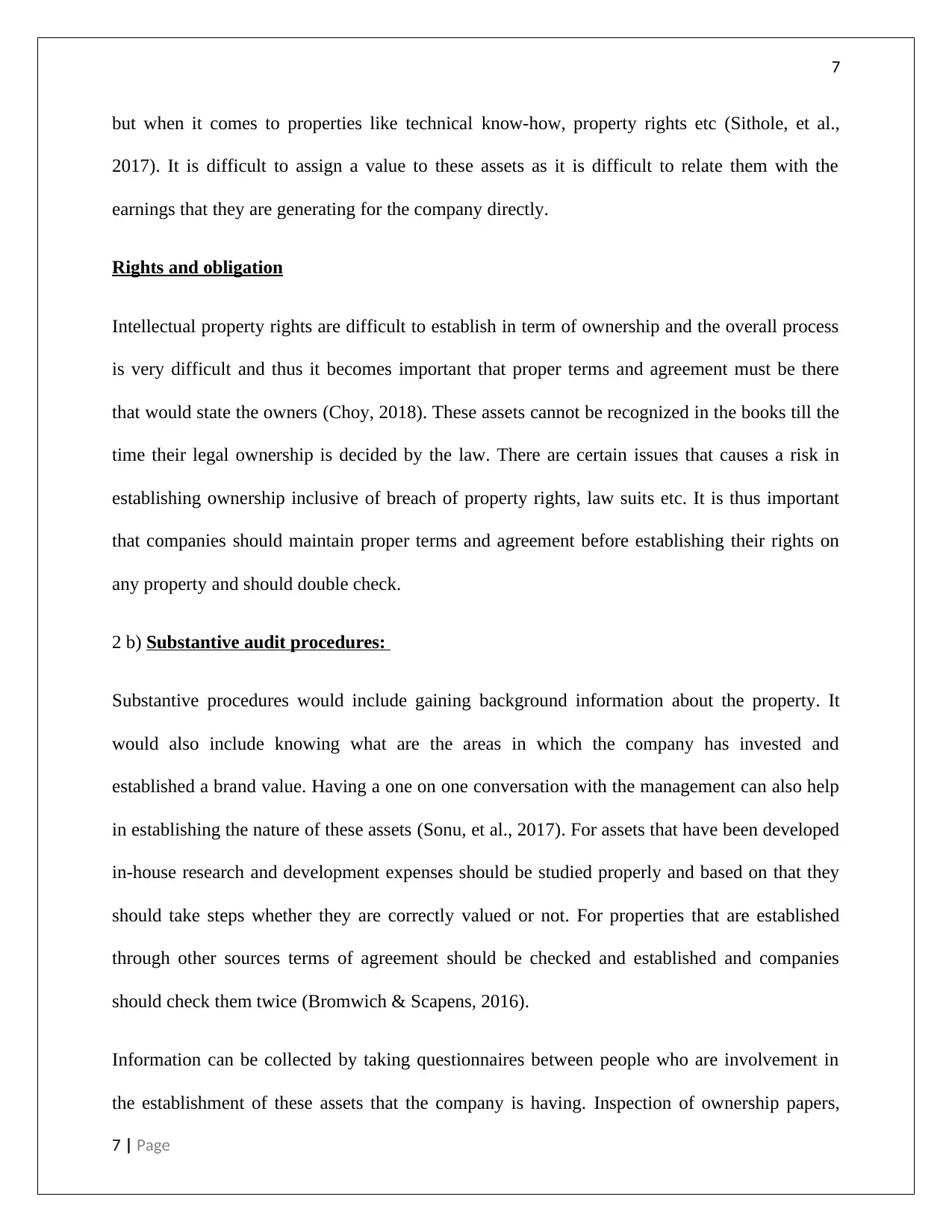
7
but when it comes to properties like technical know-how, property rights etc (Sithole, et al.,
2017). It is difficult to assign a value to these assets as it is difficult to relate them with the
earnings that they are generating for the company directly.
Rights and obligation
Intellectual property rights are difficult to establish in term of ownership and the overall process
is very difficult and thus it becomes important that proper terms and agreement must be there
that would state the owners (Choy, 2018). These assets cannot be recognized in the books till the
time their legal ownership is decided by the law. There are certain issues that causes a risk in
establishing ownership inclusive of breach of property rights, law suits etc. It is thus important
that companies should maintain proper terms and agreement before establishing their rights on
any property and should double check.
2 b) Substantive audit procedures:
Substantive procedures would include gaining background information about the property. It
would also include knowing what are the areas in which the company has invested and
established a brand value. Having a one on one conversation with the management can also help
in establishing the nature of these assets (Sonu, et al., 2017). For assets that have been developed
in-house research and development expenses should be studied properly and based on that they
should take steps whether they are correctly valued or not. For properties that are established
through other sources terms of agreement should be checked and established and companies
should check them twice (Bromwich & Scapens, 2016).
Information can be collected by taking questionnaires between people who are involvement in
the establishment of these assets that the company is having. Inspection of ownership papers,
7 | Page
but when it comes to properties like technical know-how, property rights etc (Sithole, et al.,
2017). It is difficult to assign a value to these assets as it is difficult to relate them with the
earnings that they are generating for the company directly.
Rights and obligation
Intellectual property rights are difficult to establish in term of ownership and the overall process
is very difficult and thus it becomes important that proper terms and agreement must be there
that would state the owners (Choy, 2018). These assets cannot be recognized in the books till the
time their legal ownership is decided by the law. There are certain issues that causes a risk in
establishing ownership inclusive of breach of property rights, law suits etc. It is thus important
that companies should maintain proper terms and agreement before establishing their rights on
any property and should double check.
2 b) Substantive audit procedures:
Substantive procedures would include gaining background information about the property. It
would also include knowing what are the areas in which the company has invested and
established a brand value. Having a one on one conversation with the management can also help
in establishing the nature of these assets (Sonu, et al., 2017). For assets that have been developed
in-house research and development expenses should be studied properly and based on that they
should take steps whether they are correctly valued or not. For properties that are established
through other sources terms of agreement should be checked and established and companies
should check them twice (Bromwich & Scapens, 2016).
Information can be collected by taking questionnaires between people who are involvement in
the establishment of these assets that the company is having. Inspection of ownership papers,
7 | Page
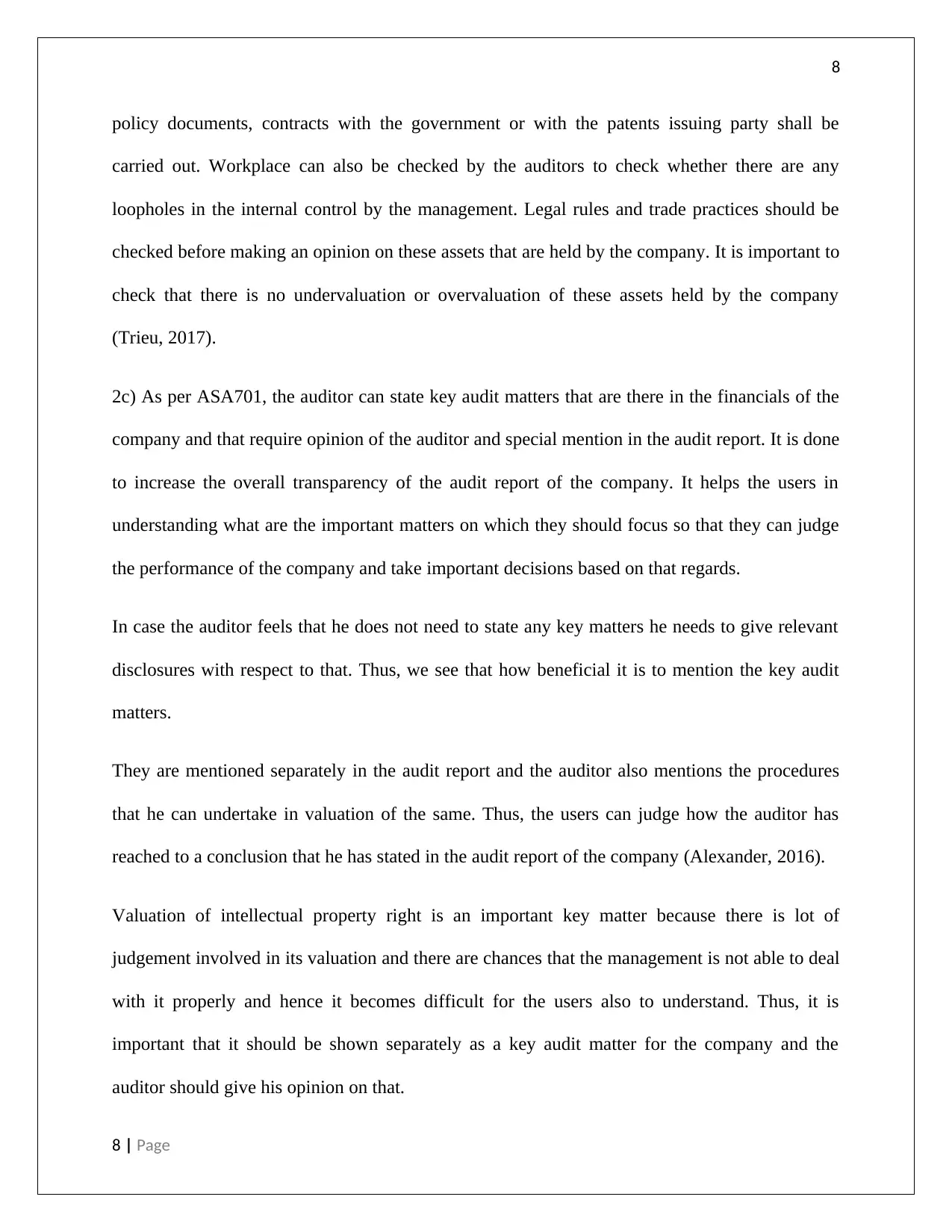
8
policy documents, contracts with the government or with the patents issuing party shall be
carried out. Workplace can also be checked by the auditors to check whether there are any
loopholes in the internal control by the management. Legal rules and trade practices should be
checked before making an opinion on these assets that are held by the company. It is important to
check that there is no undervaluation or overvaluation of these assets held by the company
(Trieu, 2017).
2c) As per ASA701, the auditor can state key audit matters that are there in the financials of the
company and that require opinion of the auditor and special mention in the audit report. It is done
to increase the overall transparency of the audit report of the company. It helps the users in
understanding what are the important matters on which they should focus so that they can judge
the performance of the company and take important decisions based on that regards.
In case the auditor feels that he does not need to state any key matters he needs to give relevant
disclosures with respect to that. Thus, we see that how beneficial it is to mention the key audit
matters.
They are mentioned separately in the audit report and the auditor also mentions the procedures
that he can undertake in valuation of the same. Thus, the users can judge how the auditor has
reached to a conclusion that he has stated in the audit report of the company (Alexander, 2016).
Valuation of intellectual property right is an important key matter because there is lot of
judgement involved in its valuation and there are chances that the management is not able to deal
with it properly and hence it becomes difficult for the users also to understand. Thus, it is
important that it should be shown separately as a key audit matter for the company and the
auditor should give his opinion on that.
8 | Page
policy documents, contracts with the government or with the patents issuing party shall be
carried out. Workplace can also be checked by the auditors to check whether there are any
loopholes in the internal control by the management. Legal rules and trade practices should be
checked before making an opinion on these assets that are held by the company. It is important to
check that there is no undervaluation or overvaluation of these assets held by the company
(Trieu, 2017).
2c) As per ASA701, the auditor can state key audit matters that are there in the financials of the
company and that require opinion of the auditor and special mention in the audit report. It is done
to increase the overall transparency of the audit report of the company. It helps the users in
understanding what are the important matters on which they should focus so that they can judge
the performance of the company and take important decisions based on that regards.
In case the auditor feels that he does not need to state any key matters he needs to give relevant
disclosures with respect to that. Thus, we see that how beneficial it is to mention the key audit
matters.
They are mentioned separately in the audit report and the auditor also mentions the procedures
that he can undertake in valuation of the same. Thus, the users can judge how the auditor has
reached to a conclusion that he has stated in the audit report of the company (Alexander, 2016).
Valuation of intellectual property right is an important key matter because there is lot of
judgement involved in its valuation and there are chances that the management is not able to deal
with it properly and hence it becomes difficult for the users also to understand. Thus, it is
important that it should be shown separately as a key audit matter for the company and the
auditor should give his opinion on that.
8 | Page
⊘ This is a preview!⊘
Do you want full access?
Subscribe today to unlock all pages.

Trusted by 1+ million students worldwide
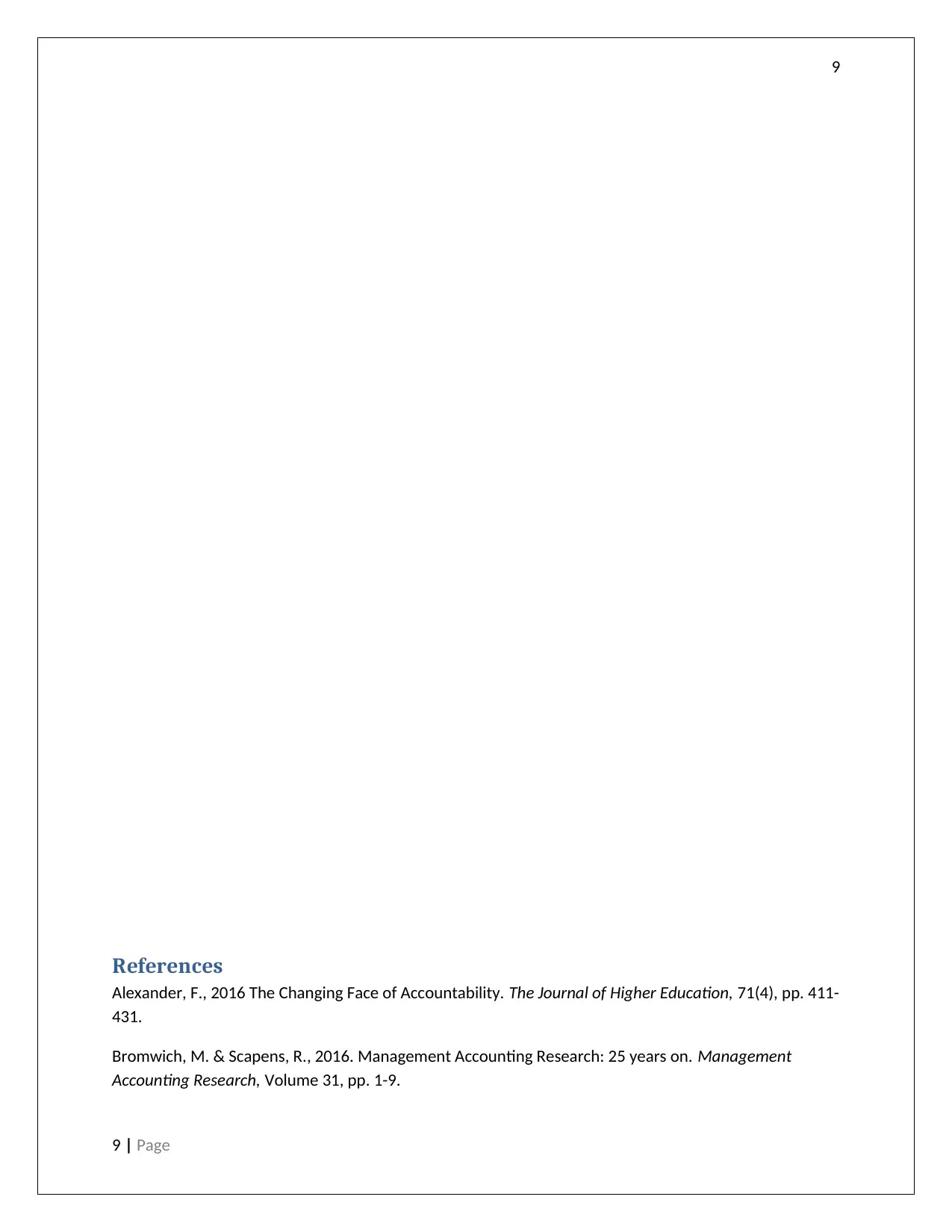
9
References
Alexander, F., 2016 The Changing Face of Accountability. The Journal of Higher Education, 71(4), pp. 411-
431.
Bromwich, M. & Scapens, R., 2016. Management Accounting Research: 25 years on. Management
Accounting Research, Volume 31, pp. 1-9.
9 | Page
References
Alexander, F., 2016 The Changing Face of Accountability. The Journal of Higher Education, 71(4), pp. 411-
431.
Bromwich, M. & Scapens, R., 2016. Management Accounting Research: 25 years on. Management
Accounting Research, Volume 31, pp. 1-9.
9 | Page
Paraphrase This Document
Need a fresh take? Get an instant paraphrase of this document with our AI Paraphraser
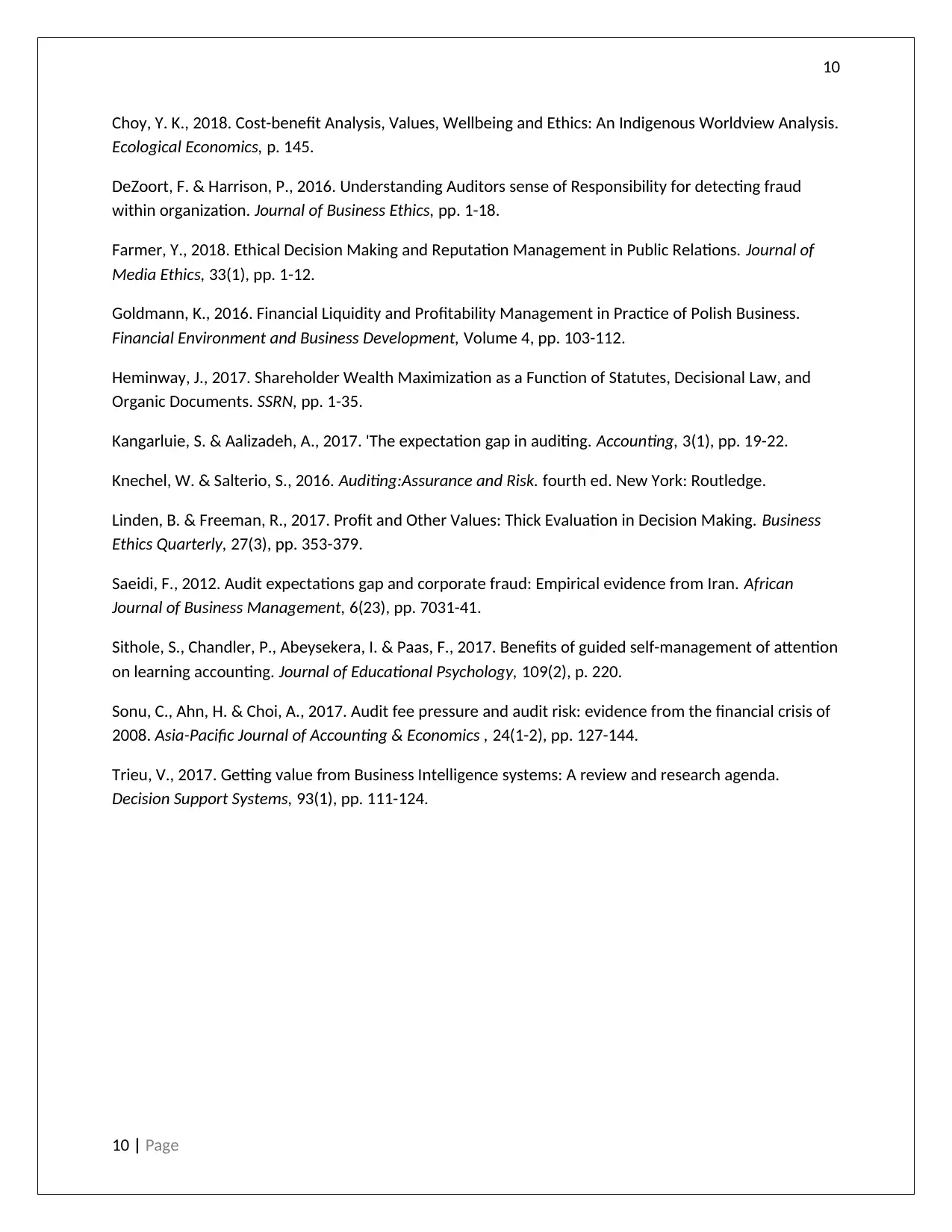
10
Choy, Y. K., 2018. Cost-benefit Analysis, Values, Wellbeing and Ethics: An Indigenous Worldview Analysis.
Ecological Economics, p. 145.
DeZoort, F. & Harrison, P., 2016. Understanding Auditors sense of Responsibility for detecting fraud
within organization. Journal of Business Ethics, pp. 1-18.
Farmer, Y., 2018. Ethical Decision Making and Reputation Management in Public Relations. Journal of
Media Ethics, 33(1), pp. 1-12.
Goldmann, K., 2016. Financial Liquidity and Profitability Management in Practice of Polish Business.
Financial Environment and Business Development, Volume 4, pp. 103-112.
Heminway, J., 2017. Shareholder Wealth Maximization as a Function of Statutes, Decisional Law, and
Organic Documents. SSRN, pp. 1-35.
Kangarluie, S. & Aalizadeh, A., 2017. 'The expectation gap in auditing. Accounting, 3(1), pp. 19-22.
Knechel, W. & Salterio, S., 2016. Auditing:Assurance and Risk. fourth ed. New York: Routledge.
Linden, B. & Freeman, R., 2017. Profit and Other Values: Thick Evaluation in Decision Making. Business
Ethics Quarterly, 27(3), pp. 353-379.
Saeidi, F., 2012. Audit expectations gap and corporate fraud: Empirical evidence from Iran. African
Journal of Business Management, 6(23), pp. 7031-41.
Sithole, S., Chandler, P., Abeysekera, I. & Paas, F., 2017. Benefits of guided self-management of attention
on learning accounting. Journal of Educational Psychology, 109(2), p. 220.
Sonu, C., Ahn, H. & Choi, A., 2017. Audit fee pressure and audit risk: evidence from the financial crisis of
2008. Asia-Pacific Journal of Accounting & Economics , 24(1-2), pp. 127-144.
Trieu, V., 2017. Getting value from Business Intelligence systems: A review and research agenda.
Decision Support Systems, 93(1), pp. 111-124.
10 | Page
Choy, Y. K., 2018. Cost-benefit Analysis, Values, Wellbeing and Ethics: An Indigenous Worldview Analysis.
Ecological Economics, p. 145.
DeZoort, F. & Harrison, P., 2016. Understanding Auditors sense of Responsibility for detecting fraud
within organization. Journal of Business Ethics, pp. 1-18.
Farmer, Y., 2018. Ethical Decision Making and Reputation Management in Public Relations. Journal of
Media Ethics, 33(1), pp. 1-12.
Goldmann, K., 2016. Financial Liquidity and Profitability Management in Practice of Polish Business.
Financial Environment and Business Development, Volume 4, pp. 103-112.
Heminway, J., 2017. Shareholder Wealth Maximization as a Function of Statutes, Decisional Law, and
Organic Documents. SSRN, pp. 1-35.
Kangarluie, S. & Aalizadeh, A., 2017. 'The expectation gap in auditing. Accounting, 3(1), pp. 19-22.
Knechel, W. & Salterio, S., 2016. Auditing:Assurance and Risk. fourth ed. New York: Routledge.
Linden, B. & Freeman, R., 2017. Profit and Other Values: Thick Evaluation in Decision Making. Business
Ethics Quarterly, 27(3), pp. 353-379.
Saeidi, F., 2012. Audit expectations gap and corporate fraud: Empirical evidence from Iran. African
Journal of Business Management, 6(23), pp. 7031-41.
Sithole, S., Chandler, P., Abeysekera, I. & Paas, F., 2017. Benefits of guided self-management of attention
on learning accounting. Journal of Educational Psychology, 109(2), p. 220.
Sonu, C., Ahn, H. & Choi, A., 2017. Audit fee pressure and audit risk: evidence from the financial crisis of
2008. Asia-Pacific Journal of Accounting & Economics , 24(1-2), pp. 127-144.
Trieu, V., 2017. Getting value from Business Intelligence systems: A review and research agenda.
Decision Support Systems, 93(1), pp. 111-124.
10 | Page

11
11 | Page
11 | Page
⊘ This is a preview!⊘
Do you want full access?
Subscribe today to unlock all pages.

Trusted by 1+ million students worldwide
1 out of 12
Related Documents
Your All-in-One AI-Powered Toolkit for Academic Success.
+13062052269
info@desklib.com
Available 24*7 on WhatsApp / Email
![[object Object]](/_next/static/media/star-bottom.7253800d.svg)
Unlock your academic potential
Copyright © 2020–2025 A2Z Services. All Rights Reserved. Developed and managed by ZUCOL.




